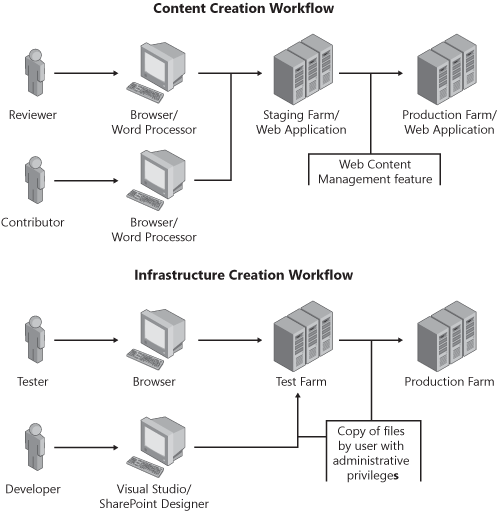This chapter will discuss best practices for using Microsoft Office SharePoint Products and Technologies for custom application development. It will outline development environment scenarios, the difference between content and infrastructure, and the three major resources that are available for custom development: Web parts, features, and solutions. Before discussing best practices for Web parts, features, and solutions, you should first understand what each is at a high level.
Web parts. Web parts are the most familiar aspect of Office SharePoint Products and Technologies development. Web parts are discrete modules of code that users can add to, move, and delete from pages. They are also user-configurable for their content, behavior, and appearance. From a utilitarian perspective, Web parts represent the opportunity to do something within a SharePoint Products and Technologies context. While they can certainly interact with and enhance SharePoint Products and Technologies, that is only a small portion of their scope of functionality. Web parts provide a means of interacting with data sources such as SQL Servers, Line-of–Business (LOB) applications like SAP, or any resource that provides a Web service interface. They are also suitable for performing tasks that have been previously accomplished with traditional page-based development.
Features. Features provide a number of ways for users to modify, enhance, extend, and interact with SharePoint Products and Technologies. There are several different types of features, each of which is designed to provide a particular valuable service. Features are more narrowly scoped than Web parts and are generally focused upon SharePoint Products and Technologies. They provide a means for performing tasks such as copying files to the content database, adding or removing items from the SharePoint Products and Technologies interface, and wiring up functionality like events and workflows.
Solutions. Solutions are packages, specifically Windows SharePoint Services 3.0 Solution Packages, that are often referred to simply as solutions or WSPs by SharePoint Products and Technologies developers. They provide integrated deployment for SharePoint Products and Technologies artifacts. Solutions are a form of CAB files that contain instructions for consumption with a SharePoint Products and Technologies environment. They reside in a single farm-wide solution store and are managed from Central Administration using STSADM.exe. Solutions provide a method of bundling Web parts, features, and their dependent resources into a single object that can be managed as a unified whole by operations.
The information stored and displayed in a SharePoint Server 2007 server farm can be generally divided into two categories: content and infrastructure. Content is the documents, list items, text, and images that are displayed on the sites in the farm. Infrastructure contains the definitions, templates, pages, and Web parts that are used to organize and present the content. Over time, the information displayed to users via SharePoint pages will change. Some of the information is date sensitive, such as event descriptions and announcements. Other information becomes less relevant and is therefore removed from high-traffic pages. Regardless of the reasons, it is important to have a clear, defined process for managing these changes.
Content is generally developed and reviewed by information workers using a Web browser or specific Microsoft Office application. Copying content from a development environment to a production environment can be accomplished by these same information workers using processes that are native to SharePoint Products and Technologies. The Web Content Management feature allows for the copying of content items from its source location to its destination location. These source and destination locations must be in different Web applications and will often be in different farms.
Infrastructure components are developed by software developers using typical development tools. Like all computer software, the components must be tested in an environment that is similar to the production location. Infrastructure components must be copied to test and production environments using administrative processes by users with administrative privileges; the Web Content Management feature will not copy these items. Figure 12-1 shows a proven content creation workflow.

